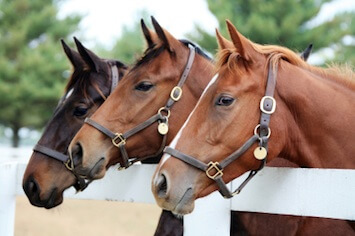Frequently Asked Questions About Equine Dental Care

What are symptoms of dental problems in my horse?
Symptoms include weight loss, slobbering, poor eating habits, tenderness around the mouth and head, head tossing, rearing, resisting the bit, and general poor performance. However, many horses have no symptoms at all.
How often should a dentist examine my horse?
All horses should be examined at least once a year. Some horses, especially seniors, require twice-annual exams and treatment. Review Dr. Warren’s recommendations for dental care by age and function.
What vaccinations or other medical information do you require before performing any dental procedure on my horse?
Tetanus toxoid is the important vaccine. Other medical information needed includes medications your horse is receiving (antibiotics, anti-inflammatory medications, hormones, joint injections, etc.), recent surgeries, diagnosed medical conditions, and if your mare is pregnant. While Dr. Warren is willing to treat a mare in early pregnancy, he feels floating mares in their last half of pregnancy may put too much stress on both mom and baby.
Is equine dental care expensive?
Not at all! Dr. Warren does not typically charge an additional fee for farm calls when a minimum number of horses are treated. Review our pricing policies for a general overview.
What kind of records does the equine dentist keep?
Just as in any veterinary office, Dr. Warren keeps thorough records of your horse’s condition, treatments, progress, and recommendations. View a sample equine dental chart.
What is floating?
Floating is the process of smoothing or removing sharp points on the outer edge of upper cheek teeth and inner edge of lower cheek teeth.
Why do horses need their teeth floated regularly?
The anatomy of the horse’s teeth is unusual in that the upper cheek teeth are wider apart than the lower cheek teeth. There would be little contact with the chewing surfaces if the horse chewed up and down. However, horses chew side-to-side, resulting in good occlusion or contact with upper and lower cheek teeth. This position of the teeth combined with the side-to-side chewing causes the surface of the teeth to wear at an angle and leave sharp points. This can eventually impede optimum chewing and result in tooth or mouth pain.One interesting fact about horses is that, unlike humans, their teeth continue to grow throughout their lives. The condition of their teeth is dynamic, constantly changing due to diet and age. Younger horses change faster, especially since most baby teeth are lost and get replaced by adult teeth between the ages of 3–5 years. This is why regular dental procedures are needed—float your 3-year-old’s teeth today, in 6 months some baby teeth are lost, new adult teeth have erupted, and they may need some work. For a 15-year-old with wave mouth, the wave can be reduced today but, since teeth continue to grow, that wave will return to some degree in 12 months.
What is “performance dentistry”?
Horses experiencing pain do not perform to their full ability, whether under saddle or in harness. In addition, poor teeth can result in a loss of condition due to an inability to process feed for complete nutrition. Finally, behavioral issues, such as balking or head tossing, may indicate an oral problem. While addressing these concerns may fall under the area of “performance dentistry,” veterinary professionals consider this to be good general preventive care and maintenance for any horse.
Dr. Warren believes that a good dental exam and procedure includes floating, equilibration, and correction of any abnormalities present in a horse’s mouth, regardless of age or lifestyle. Performance floats are for performance horses, those in training or being shown. The main additional procedure that is sometimes beneficial to a performance horse is bit seats. This makes the bit more comfortable and reduces distracting bad habits such as bit chewing, tongue rolling, and bit contact with the first cheek tooth. Not every horse will benefit from a bit seat. The veterinarian will examine the first cheek teeth, sometimes with a bit in the horse’s mouth, to determine if it is needed.
Canine tooth reduction is also a component of performance dentistry. Depending on the location of a horses canine teeth, shortening the teeth will minimize contact with the bit. Again, this depends on each horse’s conformation. In some horses, the canine teeth are far enough forward in their mouth that they pose no issues.
Informing the Community
Explore the latest news from Dr. David Warren and the world of equine dentistry.
